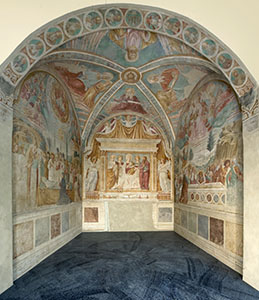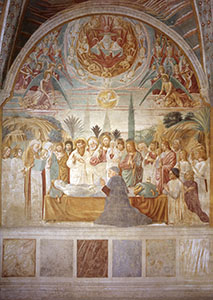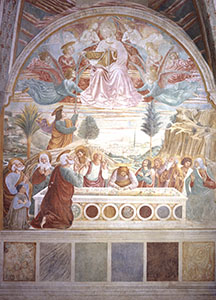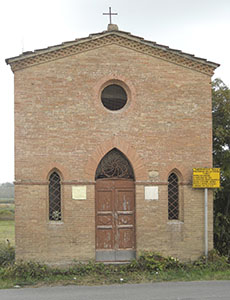
Tabernacle of the Madonna of the Cough, Benozzo Gozzoli Museum, Castelfiorentino.

The Funeral of the Virgin, Tabernacle of the Madonna of the Cough, Benozzo Gozzoli Museum, Castelfiorentino.

Assumption of the Virgin, Tabernacle of the Madonna of the Cough, Benozzo Gozzoli Museum, Castelfiorentino.

Chapel of the Madonna of the Cough, on the road between Castelnuovo and Castelfiorentino.
In 1484, after his experience in Pisa, Benozzo, with the help of his studio, frescoed the tabernacle on the road from Castelfiorentino to Castelnuovo d'Elsa with the Dormition of the Virgin, which came to be known as the Madonna of the Cough as a result of the constant devotion of the local people to this chapel.
Indeed, whooping cough, pertussis or "tosse cattiva" (bad cough), as it was called in Tuscany, was a very common illness until a few years ago, mainly affecting children and causing a violent, barking cough. This was not only bothersome but could become fatal, and it was therefore customary among the faithful to erect shrines dedicated to the Virgin Mary, where mothers would accompany children suffering from the epidemic. Some of the most important examples are the tabernacle built in the early sixteenth century in Florence, near San Gallo Gate, and transformed into an oratory in 1595 by the Grand Duchess Cristina di Lorena following the grace granted to her own children.
The fresco within a clypeus on the cross-vaulted ceiling of the Tabernacle of the Madonna of the Cough depicts a Jesus in the act of blessing, while those on the webs depict the four Apostles with their customary iconographic attributes: Mark with the lion, Luke with the ox, Matthew with the angel and John with the eagle.
Frescoed on the central wall is a sophisticated and effective trompe l'oeil altarpiece, with five angels pulling back the cloth to reveal the Virgin and Child enthroned surrounded by Saints Peter, Catherine of Alexandria, Margaret and Paul. In an asymmetrical position in front of the main scene, there is a small icon with an effigy of the Holy Face which, thanks to the illusionistic effect, appears casually placed on the trompe l'oeil altar-step. A period photo documenting the frescoes before their removal illustrates the stone altar that was placed against the wall, highlighting how this image simulated the fixtures of a real religious altar made ready for Holy Mass.
The scene of the Funeral of the Virgin occupies the right-hand wall. Participating in this holy event is Messer Grazia of Castelnuovo, the work's commissioner, kneeling in the foreground. The fresco on the left-hand wall depicts the Assumption of the Virgin to Heaven, interpreted according to the Golden Legend by Jacopo da Varagine (+ 1298), showing the Madonna that throws the belt to Saint Thomas, the twelfth Apostle who doubted the Resurrection of Christ. The image of the Virgin Mary, ascending to Heaven and throwing her belt down to the Apostle Thomas appears in many paintings and sculptures, for example in the images of the Assumption by Agnolo Gaddi in the Cathedral of St. Stephen (Prato, Tuscany), Andrea Orcagna in Orsanmichele (Florence), Ghirlandaio in Santa Maria Novella (Florence) and Pinturicchio in Santa Maria del Popolo (Rome) and in various terracotta works by Della Robbia (in Foiano and La Verna in the Province of Arezzo). It may be noted that this episode was depicted almost exclusively by Italian artists, which is not surprising since Prato boasted and continues to boast the relic of the belt which, according to legend, came from Palestine. In reality, it probably came from Constantinople where it was greatly revered before being brought to Italy.
Despite the high quality of these frescoes, critics believe it to be the fruit of collaboration by Benozzo's studio and particularly his son, Francesco. The contribution of his sons, Alesso and Francesco, was explicitly cited, on the other hand, in a lost inscription on the Tabernacle of the Visitation.
In 1853, the Tabernacle of the Madonna of the Cough was encased in a neo-Gothic chapel, transforming it into an oratory, in order to preserve it. This solution did not, however, prevent the decay of the frescoes caused by the high humidity levels. In 1970, the authorities responsible for their protection therefore deemed it opportune to remove them from the walls and carry out careful restoration.
Indeed, a thick layer of limescale had formed over the frescoes and, particularly in the lower areas, the humidity had resulted in sulphation of the plasterwork, a chemical process which causes a reaction in the calcium carbonate (the main element of which frescoes consist), forming calcium sulphate, commonly known as gypsum. This phenomenon can cause the frescoes to become "dusty", i.e. lose their pigment if touched, or, if the plaster is compact and non-porous, the gypsum can form bubbles which later burst. The restoration work consisted, above all, of making good the raised and dusty areas of colour, after which the frescoes were affixed to a fibreglass backing and carefully cleaned using ammonium carbonate (a salt also contained in baking powder) and distilled water
Of course, the colours that the artist had applied "dry" were entirely lost. In the areas of the frescoes containing gaps, it was decided to carry out pictorial restoration with a "neutral shade".
Since it was impossible to return the work to its original site (as a small stream runs under the chapel causing excessive dampness), it remained in storage in the Florentine Fine Art Superintendence until 1987, when it was decided that the frescoes should be exhibited in the Municipal Library in Castelfiorentino. While this arrangement allowed Benozzo Gozzoli's work, previously hidden from view, to be admired, it also prevented the tabernacle from being reconstructed in its entirety. Indeed, the chosen venue prevented the display of the painted imitation marble skirting which adorned the lower register.
From January 2009, however, this tabernacle, together with the Tabernacle of the Visitation, will be more suitably placed in the new venue, the Benozzo Gozzoli Museum, especially designed to house these magnificent pieces of architecture. The frescoes of both tabernacles have been restored for the occasion.
In the small oratory on the road from Castelfiorentino to Castelnuovo, the original site of the frescoes of the Madonna of the Cough, the sinopia (preparatory drawing) of the scene depicting the Virgin and Child enthroned was discovered, traces of which were also visible in the photographs taken during the removal of the frescoes.
This discovery once again confirms Benozzo's regular use of the sinopia technique for the preparatory drawings of his works, and disproves what scholars had conjectured, namely that Gozzoli would prepare the drawings on cardboard and then entrust them to his close collaborators to copy out using the "spolvero" (dusting) technique for the painting of the frescoes.
Serena Nocentini